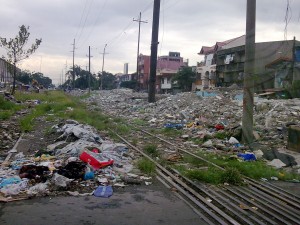By Allen T. Navasero
The term ‘slum’ generally refers to a once attractive neighborhood that has deteriorated’ (Kramer). Although different localities often have their own words to define slums, Kramer’s definition of a ‘slum’ is accurate for those in Metro Manila. In fact, there is no word in the Tagalog dictionary for ‘slum’ in the Philippines, other than the informal word ‘iskwater’ which translates to ‘The place for the squatters’.
True to Kramer’s definition, slums in Metro Manila, as difficult as it may be to believe, were indeed once pristine places to live. Kramer illustrates the Balic Balic neighborhood in the Sampaloc district of Metro Manila as it once was in the 1960s, through the recollections of resident Tess Esguerra. ‘Her family squatted on then-unoccupied land near railroad tracks and built a house amidst flourishing, lush vegetation, 100 yards from the next home’, ‘They caught fish from a nearby canal’ where water lilies and kangkong [swamp cabbage] flourished (Kramer 12). Today, Tess Essguerra and other Balic-Balic community residents ‘use the putrid canal only to dump waste’ (ibid). How did such a once pristine living community become a polluted land of filth, comparable to Dicken’s descriptions of early industrial London?
The answer lies in rapid urban migration and urban population growth. In 1963, only four families lived along railway tracks in the Balic Balic community, in 2006, this number exploded to more than 200 families (Kramer 12). Zooming out onto the population of Metro-Manila: In 1950, 1.5 million people, and in 2006, 10.6 million people (Kramer 27). The forces pulling these people into the city include the expectation of higher paying jobs, higher food security, and living in ‘a more controlled environment’ where ‘life is less risky’ (Kramer 19). As a result of such rapid urbanization, Metro-Manila, with omnipresent state corruption, was unable to plan accordingly to accommodate its new city residents. Whilst then rapidly industrializing cities such as London enjoyed much slower growth rates and cheap raw materials and labor from its empires colonies, giving the city more time and resources to respond to urban population growth, rapidly growing urban areas such as Metro Manila in the Global South do not share the same luxuries. Given the omnipresent corruption in the Philippine government, ‘Most city officials lack the will to work towards solutions, and corruption undermines the efforts of more dedicated leaders. Many cities have been poorly planned, if they planned at all, and they lack a plan for the future’ (Kramer 30).
An Introduction to the Balic Balic Railroad Community
Part II: Localities in Metro Manila Slums
Kramer, Mark. Dispossessed: Life in Our World’s Urban Slums. Maryknoll, New York: Orbis Books, 2006. Print.

